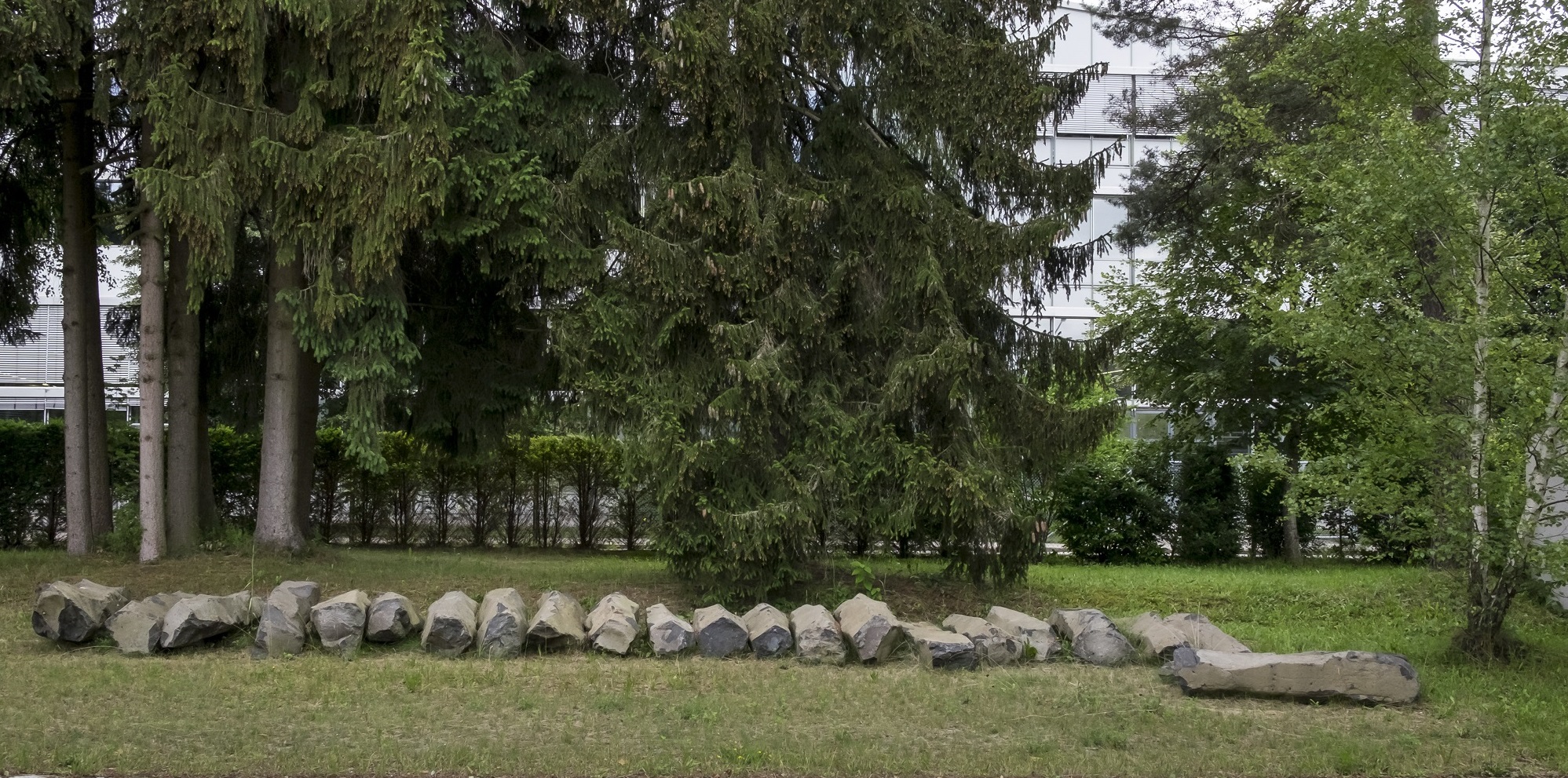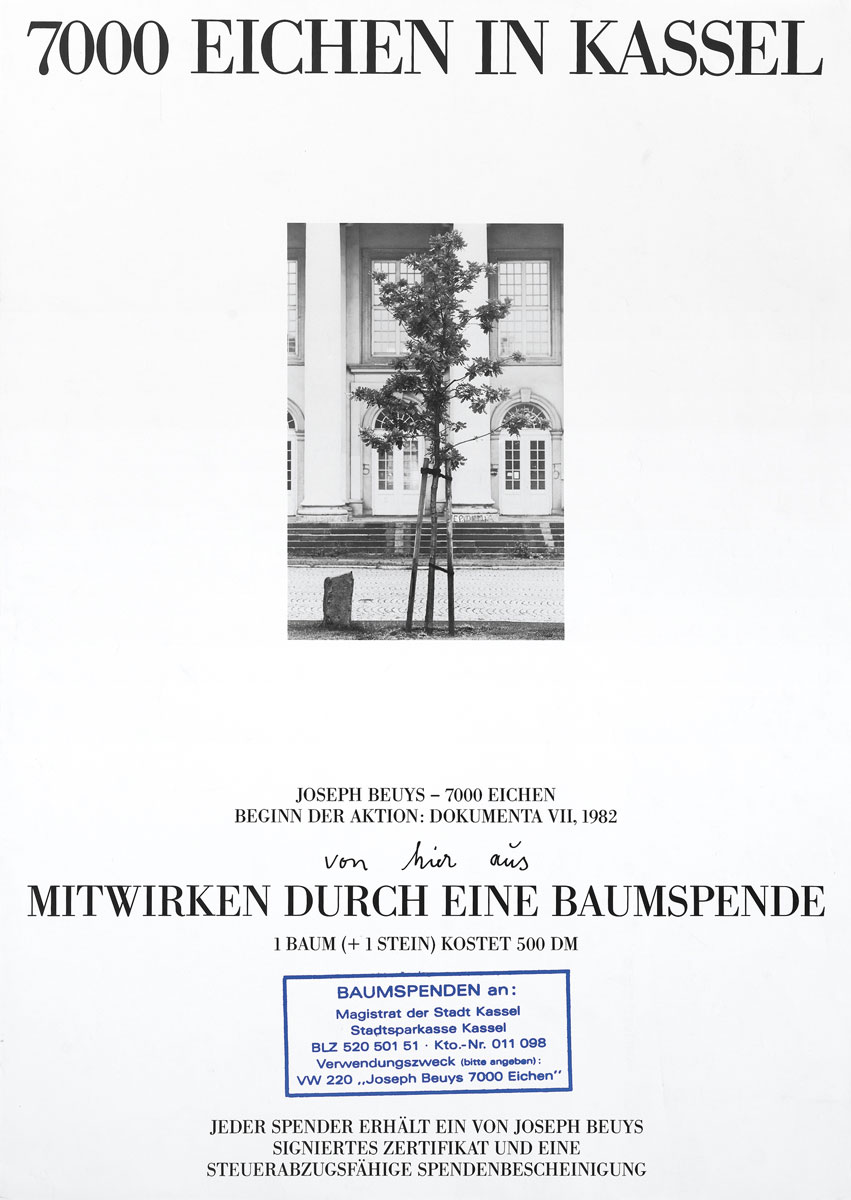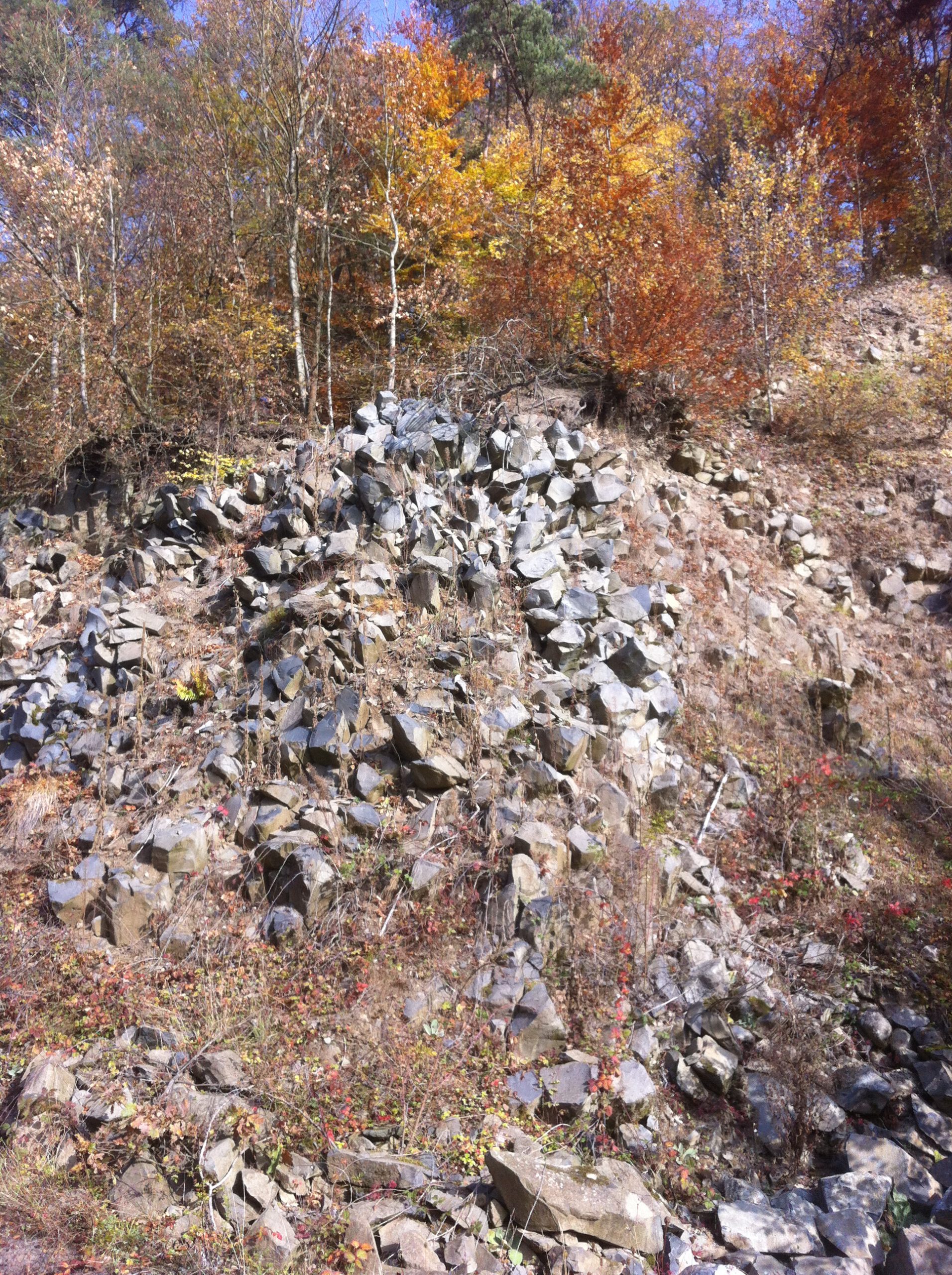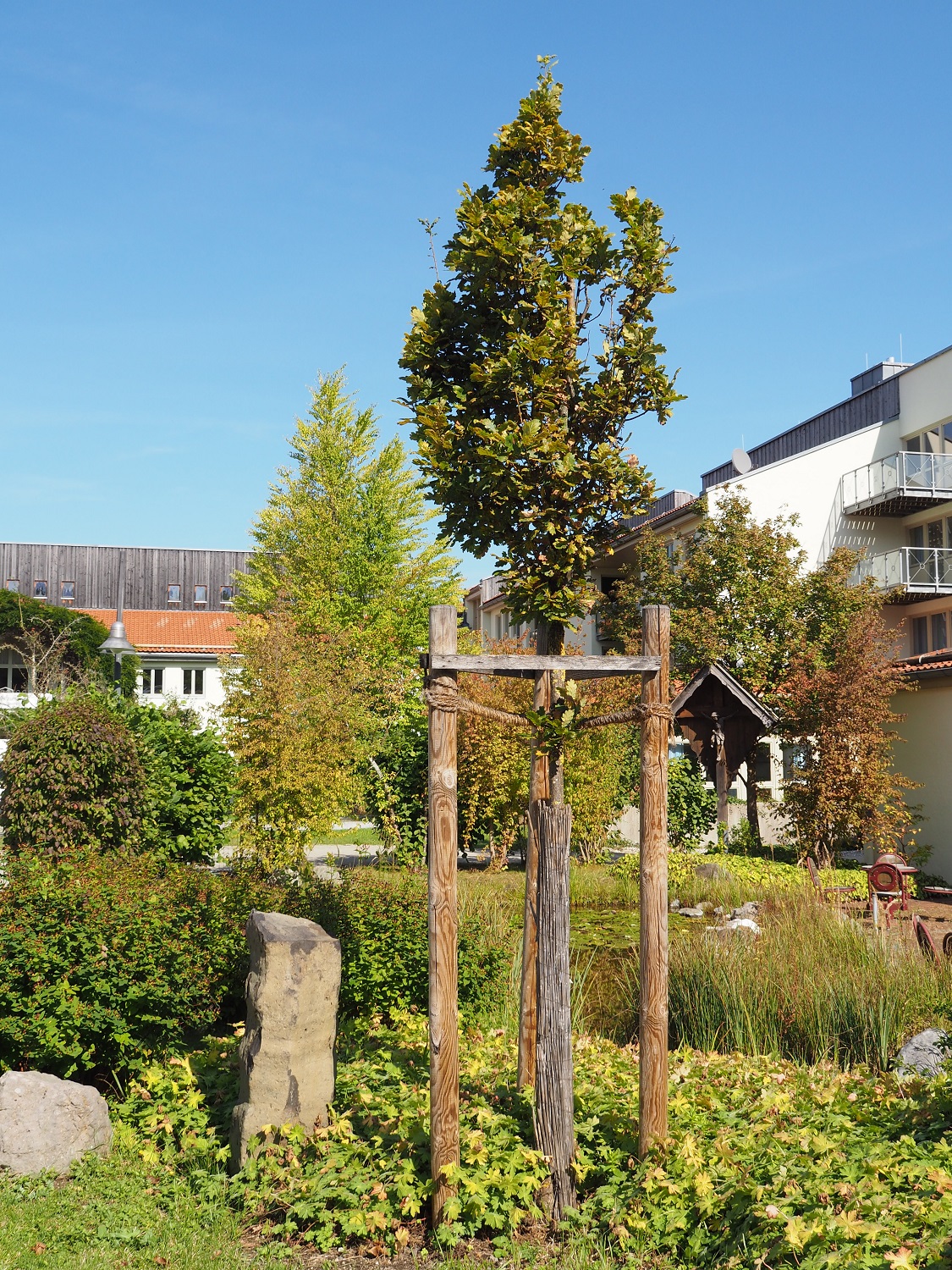OAK PLANTING IN HONOR OF JOSEPH BEUYS
". . . for we never want to end the planting action!" Joseph Beuys

When sculptor and performance artist Joseph Beuys in 1982 planted the first of 7,000 trees in Kassel for documenta 7, it marked the beginning of a seemingly utopian Gesamtkunstwerk of unprecedented dimensions. Despite all opposition to "7000 Oaks – City Forestation Instead of City Administration", the last oak tree was planted next to the first one in 1987 for documenta 8 with the help of numerous donators and individual sponsorships.
The DASMAXIMUM Foundation in Traunreut has been honoring the artist and his work since 2015 with the "OAK PLANTATIONS IN HONOR OF JOSEPH BEUYS" project. For his 100th birthday in 2021, the idea was born to expand the project and plant it nationwide. A total of at least 64 basalt stones - one for each year of the artist's life - are to be planted together with a tree.

Advertising poster for a tree donation for the "7000 Oaks" in Kassel.
Archive DASMAXIMUM
"7000 oaks - city forestation instead of city administration", 1982-1987, Kassel.
Today, the "7000 Oaks" are considered the epitome of the concept of "social sculpture". With this term Beuys expanded the common art forms by aesthetic, ecological, economic and philosophical aspects, but above all by social ideas: the essential cooperation of all citizens, from politicians to residents. Already in the context of the Kassel project, Joseph Beuys conceived the vision of a worldwide planting campaign. In 1982, Heiner Friedrich, through the Dia Art Foundation, which he co-founded in New York, donated the 7000 basalt steles for the "7000 Oaks" in Kassel - and thus facilitated the start of the largest art project in public space to date. It was also Heiner Friedrich who continued "7000 Oaks" 1988-1996 in New York City and in 2012 - one year after the opening of his museum DASMAXIMUM KunstGegenwart in Traunreut - initiated the "Oak Planting in Honor of Joseph Beuys" in and around Traunreut with the last available stelae from the quarry near Landsburg/Hessen, used for the Kassel project and now under nature preservation.
The "Oak planting in honor of Joseph Beuys".
Next to each of the growing, living trees stands a million-year-old basalt as a mineral donor and stable "guardian". Over the course of time, the proportions are reversed and the stone is overtaken and "guarded" by the oak. The elements of the "7000 Oaks", as well as those of the "Oak Plantation in Honor of Joseph Beuys", reflect the work of the exceptional artist in a very special way: the tree as living matter that changes and develops and the basalts as a symbol of the spirit in their verticality and permanence. Basalt columns consist of lava that was ejected from the earth millions of years ago and solidified into pentagonal or hexagonal stone columns in the volcanic cone as a result of thermodynamic processes during cooling. They originate from the deepest past, while the growth of the trees goes into the future and is a sign of the revitalization of the earth by man. Past and future meet in the shared presence of oak and basalt.

The Landsburg basalt quarry, source for the majority of the basalt stelae for the "7000 Oaks" in Kassel and also partly for the "Oak Planting in Honor of Joseph Beuys".
Photo: DASMAXIMUM

Tree and basalt stele in Traunreut at the entrance of the Realschule at the Jugendsiedlung.
Photo: DASMAXIMUM
The "Oak Planting in Honor of Joseph Beuys" honors the lifetime achievement of an artist whos essential concern was a positive, meaningful and healing work for society and nature in general. Against the backdrop of increasing ecological awareness, his work is more topical than ever. Thanks to the cooperation with Eva Beuys, the artist´s widow, Johannes Stüttgen, master student and lifelong companion of Joseph Beuys, and Norbert Scholz, landscape planner and coordinator of the Kassel oak planting, the "Oak Planting in Honor of Joseph Beuys" can be implemented as close to the ideas of the artist as possible. Thus the spirit of one of the most important, lively and pioneering works of art of the 20th century can be carried on.
In the anniversary year of Joseph Beuys' 100th birthday in 2021, the planting campaigns took place throughout Bavaria and beyond its borders as part of a cooperation with STADTKULTUR-Netzwerk Bayerischer Städte e.V. Oak plantings in honor of Joseph Beuys can also be found in places significant to Joseph Beuys, such as the Hessian State Museum in Darmstadt.
Further info: DASMAXIMUM, phone 08669 1203713 or
Email eichen@dasmaximum.com
Joseph Beuys
Joseph Beuys (1921 Krefeld - 1986 Düsseldorf), sculptor, painter and performance artist, born in Krefeld in 1921, studied sculpture at the State Academy of Art in Düsseldorf. 1961-1972 professor for monumental sculpture at the State Academy of Art in Düsseldorf. Joint action for the good of society, creativity as a positive human disposition, nature as the epitome of growth, a habitat worthy of protection, and art as a unifying, clarifying, and admonishing process were essential aspects of Joseph Beuys' work.
"I wanted this long-term character, [...], that is, to make something that will really only unfold in a hundred, two hundred, three hundred years, that now actually only a beginning is set: There is a tree planted, there is a stone next to it that marks: In this time, in which we think about these whole questions of the revival of lifelines in nature, which is, after all, in danger through the general destruction of inhuman economic activity, that at this time, therefore, people have set out and have once turned the direction around, in order to bring back into the discussion, therefore, with a very simple, primitive beginning, to put a tree into the earth, all the necessities connected with it, also all the theories, philosophies, etc., connected with it."
c.a.: Scholz, Norbert: Joseph Beuys : 7000 Eichen in Kassel = Joseph Beuys : 7000 chênes à Kassel = JosephBeuys : 7000 oaks in Kassel, in: Anthos. Zeitschrift für Landschaftsarchitektur = Une revue pour lepaysage, vol 25 (1986), S. 31-35, S. 32.
